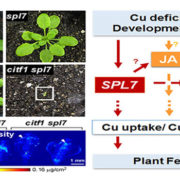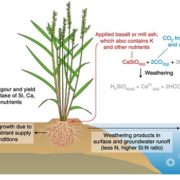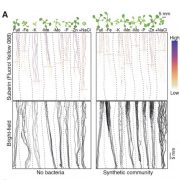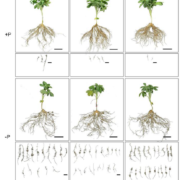An SPX-RLI1 module regulates leaf inclination in response to phosphate availability in rice (Plant Cell)
 The angle at which a rice leaf bends affects its ability to intercept light and also the density at which the plants can be sown. Previous work has shown that brassinosteroid hormones and the BRASSINOSTEROID UPREGULATED1 (BU1) gene affect leaf angle. Ruan, Guo, Xu et al. investigated the role of phosphate (Pi) availability in leaf angle; leaves are more erect in low Pi conditions (which interfere with effective photosynthesis), possibly to reduce light capture. The authors showed that the Pi starvation-induced proteins SPX1 and 2, and an SPX1-interacting protein RLI1 (Regulator of Leaf Inclination 1) are involved in BU1 regulation and leaf angle responses to Pi. RLI1 positively regulates cell extension in the leaf lamina (hinge) joint, leading to an increase in leaf angle, which is suppressed in low-Pi. This work then connects leaf angle and Pi sufficiency, which could lead to the production of “new rice cultivars with different canopy forms that are sensitive or insensitiveto Pi availability, which might help to increase Pi efficiency in field.” (Summary by Mary Williams) Plant Cell 10.1105/tpc.17.00738
The angle at which a rice leaf bends affects its ability to intercept light and also the density at which the plants can be sown. Previous work has shown that brassinosteroid hormones and the BRASSINOSTEROID UPREGULATED1 (BU1) gene affect leaf angle. Ruan, Guo, Xu et al. investigated the role of phosphate (Pi) availability in leaf angle; leaves are more erect in low Pi conditions (which interfere with effective photosynthesis), possibly to reduce light capture. The authors showed that the Pi starvation-induced proteins SPX1 and 2, and an SPX1-interacting protein RLI1 (Regulator of Leaf Inclination 1) are involved in BU1 regulation and leaf angle responses to Pi. RLI1 positively regulates cell extension in the leaf lamina (hinge) joint, leading to an increase in leaf angle, which is suppressed in low-Pi. This work then connects leaf angle and Pi sufficiency, which could lead to the production of “new rice cultivars with different canopy forms that are sensitive or insensitiveto Pi availability, which might help to increase Pi efficiency in field.” (Summary by Mary Williams) Plant Cell 10.1105/tpc.17.00738









